High-Cycle Fatigue Behavior and Fatigue Strength Prediction of Differently Heat-Treated 35CrMo Steels
Abstract
:1. Introduction
2. Experimental Materials and Procedures
3. Results and Discussion
3.1. Microstructure
3.2. Tensile Behaviors
3.3. High-Cycle Fatigue Behaviors
3.4. Prediction of Fatigue Strength
4. Conclusions
- (1)
- With the increase of tempering temperature, martensite is gradually decomposed and the tensile strength decreases, but the yield strength and fatigue strength increase at first and then decrease. QT200 specimens have the best fatigue performance;
- (2)
- To some extent, the yield strength affects the ratio of crack initiation site for a specimen, and the crack initiation site affects the fatigue strength coefficient and fatigue strength exponent. Therefore, the yield strength affects the change of fatigue strength coefficient and fatigue strength exponent, and they have a linear relation for HCF tests of 35CrMo steel;
- (3)
- A fatigue strength prediction method based on the damage mechanisms and Basquin equation was proposed. In this way, the values of fatigue strength coefficient, fatigue strength exponent, and knee point can be expressed by yield strength. This method can effectively predict the HCF strength of 35CrMo steel. The fatigue strength coefficient, fatigue strength exponent, and knee point are affected by many factors, and it is still necessary to further explore whether this method is suitable for other materials.
Author Contributions
Funding
Institutional Review Board Statement
Informed Consent Statement
Data Availability Statement
Acknowledgments
Conflicts of Interest
References
- Tanaka, K.; Shimonishi, D.; Nakagawa, D.; Ijiri, M.; Yoshimura, T. Stress relaxation behavior of cavitation-processed Cr-Mo steel and Ni-Cr-Mo steel. Appl. Sci. 2019, 9, 299. [Google Scholar] [CrossRef] [Green Version]
- Raj, B.; Choudhary, B.; Raman, R.S. Mechanical properties and non-destructive evaluation of chromium–molybdenum ferritic steels for steam generator application. Int. J. Press. Vessel. Pip. 2004, 81, 521–534. [Google Scholar] [CrossRef]
- Ma, K.; Zheng, J.; Hua, Z.; Gu, C.; Zhang, R.; Liu, Y. Hydrogen assisted fatigue life of Cr–Mo steel pressure vessel with coplanar cracks based on fatigue crack growth analysis. Int. J. Hydrogen Energy 2020, 45, 20132–20141. [Google Scholar] [CrossRef]
- Zhang, J.; Lu, L.; Wu, P.; Ma, J.; Wang, G.; Zhang, W. Inclusion size evaluation and fatigue strength analysis of 35CrMo alloy railway axle steel. Mater. Sci. Eng. A 2013, 562, 211–217. [Google Scholar] [CrossRef]
- Lv, Y. Influence of laser surface melting on the micropitting performance of 35CrMo structural steel gears. Mater. Sci. Eng. A 2013, 564, 1–7. [Google Scholar] [CrossRef]
- Takemasu, T.; Koide, T.; Shinbutsu, T.; Sasaki, H.; Takeda, Y.; Nishida, S. Effect of Surface Rolling on Load Bearing Capacity of Pre-alloyed Sintered Steel Gears with Different Densities. Procedia Eng. 2014, 81, 334–339. [Google Scholar] [CrossRef] [Green Version]
- Shi, H.Q.; Ding, Y.; Ma, L.Q.; Shen, X.D. Corrosion Failure Analysis of 35CrMo Bolt in Wet Hydrogen Sulfide Environment. Appl. Mech. Mater. 2013, 291–294, 2605–2609. [Google Scholar] [CrossRef]
- Gaur, V.; Doquet, V.; Persent, E.; Roguet, E. Effect of biaxial cyclic tension on the fatigue life and damage mechanisms of Cr–Mo steel. Int. J. Fatigue 2016, 87, 124–131. [Google Scholar] [CrossRef]
- Zheng, X.T.; Wu, K.W.; Wang, W.; Yu, J.Y.; Xu, J.M.; Ma, L.W. Low cycle fatigue and ratcheting behavior of 35CrMo structural steel at elevated temperature. Nucl. Eng. Des. 2017, 314, 285–292. [Google Scholar] [CrossRef]
- Hua, Z.; Zhang, X.; Zheng, J.; Gu, C.; Cui, T.; Zhao, Y.; Peng, W. Hydrogen-enhanced fatigue life analysis of Cr–Mo steel high-pressure vessels. Int. J. Hydrogen Energy 2017, 42, 12005–12014. [Google Scholar] [CrossRef]
- Wei, W.; Feng, Y.; Han, L.; Zhang, Q.; Zhang, J. Cyclic hardening and dynamic strain aging during low-cycle fatigue of Cr-Mo tempered martensitic steel at elevated temperatures. Mater. Sci. Eng. A 2018, 734, 20–26. [Google Scholar] [CrossRef]
- Ogawa, Y.; Matsunaga, H.; Yamabe, J.; Yoshikawa, M.; Matsuoka, S. Fatigue limit of carbon and Cr Mo steels as a small fatigue crack threshold in high-pressure hydrogen gas. Int. J. Hydrogen Energy 2018, 43, 20133–20142. [Google Scholar] [CrossRef]
- Zhang, J.; Lu, L.; Shiozawa, K.; Zhou, W.; Zhang, W. Effect of nitrocarburizing and post-oxidation on fatigue behavior of 35CrMo alloy steel in very high cycle fatigue regime. Int. J. Fatigue 2011, 33, 880–886. [Google Scholar] [CrossRef]
- Samant, S.; Pandey, V.; Singh, I.; Singh, R. Effect of double austenitization treatment on fatigue crack growth and high cycle fatigue behavior of modified 9Cr–1Mo steel. Mater. Sci. Eng. A 2020, 788, 139495. [Google Scholar] [CrossRef]
- Zhao, Z.L.; Li, C.F. Metal Technology; Beijing Institute of Technology Press: Beijing, China, 2019. [Google Scholar]
- Shaeri, M.; Saghafian, H.; Shabestari, S. Effect of heat treatment on microstructure and mechanical properties of Cr–Mo steels (FMU-226) used in mills liner. Mater. Des. 2012, 34, 192–200. [Google Scholar] [CrossRef]
- Laxmi, B.; Sharma, S.; Pk, J.; Hegde, A. Quenchant oil viscosity and tempering temperature effect on mechanical properties of 42CrMo4 steel. J. Mater. Res. Technol. 2021, 16, 581–587. [Google Scholar] [CrossRef]
- Gao, C.; Yang, M.; Pang, J.; Li, S.; Zou, M.; Li, X.; Zhang, Z. Abnormal relation between tensile and fatigue strengths for a high-strength low-alloy steel. Mater. Sci. Eng. A 2021, 832, 142418. [Google Scholar] [CrossRef]
- Pang, J.; Li, S.; Wang, Z.; Zhang, Z. General relation between tensile strength and fatigue strength of metallic materials. Mater. Sci. Eng. A 2013, 564, 331–341. [Google Scholar] [CrossRef]
- Pang, J.C.; Li, S.X.; Wang, Z.G.; Zhang, Z.F. Relations between fatigue strength and other mechanical properties of metallic materials. Fatigue Fract. Eng. Mater. Struct. 2014, 37, 958–976. [Google Scholar] [CrossRef]
- Murakami, Y. Metal Fatigue: Effect of Small Defects and Nonmetallic Inclusions, 2nd ed.; Elsevier Ltd.: Amsterdam, The Netherlands, 2019. [Google Scholar]
- Li, S.X. Effects of inclusions on very high cycle fatigue properties of high strength steels. Int. Mater. Rev. 2012, 57, 92–114. [Google Scholar] [CrossRef]
- Murakami, Y.; Takagi, T.; Wada, K.; Matsunaga, H. Essential structure of S-N curve: Prediction of fatigue life and fatigue limit of defective materials and nature of scatter. Int. J. Fatigue 2021, 146, 106138. [Google Scholar] [CrossRef]
- Liu, Q.; Zhu, G.; Pang, J.; Liu, F.; Li, S.; Guo, C.; Jiang, A.; Zhang, Z. High-cycle fatigue properties prediction and damage mechanisms of RuT400 compacted graphite iron at different temperatures. Mater. Sci. Eng. A 2019, 764, 138248. [Google Scholar] [CrossRef]
- Liu, Y.; Li, Y.; Li, S.; Yang, Z.; Chen, S.; Hui, W.; Weng, Y. Prediction of the S–N curves of high-strength steels in the very high cycle fatigue regime. Int. J. Fatigue 2010, 32, 1351–1357. [Google Scholar] [CrossRef]
- Murakam, Y.; Nomoto, T.; Ueda, T. Factors influencing the mechanism of superlong fatigue failure in steels. Fatigue Fract. Eng. Mater. Struct. 1999, 22, 581–590. [Google Scholar] [CrossRef]
- Duan, Q.Q.; Pang, J.C.; Zhang, P.; Li, S.X.; Zhang, Z.F. Quantitative relations between S-N curves parameters and tensile strength for two steels: AISI 4340 and SCM 435. Res. Rev. J. Mater. Sci. 2018, 6, 1–16. [Google Scholar]
- Shiozawa, K.; Lu, L. Very high-cycle fatigue behaviour of shot-peened high-carbon-chromium bearing steel. Fatigue Fract. Eng. Mater. Struct. 2002, 25, 813–822. [Google Scholar] [CrossRef]
- Petit, J.; Sarrazin-Baudoux, C. An overview on the influence of the atmosphere environment on ultra-high-cycle fatigue and ultra-slow fatigue crack propagation. Int. J. Fatigue 2006, 28, 1471–1478. [Google Scholar] [CrossRef]
- Lee, Y.L.; Pan, J.; Hathaway, R.B.; Barkey, M.E. Fatigue Testing and Analysis: Theory and Practice; Butterworth-Heinemann: Waltham, MA, USA, 2005. [Google Scholar]
- Gan, Y.; Tian, Z.L.; Dong, H.; Feng, D.; Xin, X.L. China Materials Engineering Canon Steel Materials Engineering; Chemical Industry Press: Beijing, China, 2005; Volume 3. [Google Scholar]
- Zhao, N.; Zhao, Q.; He, Y.; Liu, R.; Liu, W.; Zheng, W.; Li, L. Strengthening-toughening mechanism of cost-saving marine steel plate with 1000 MPa yield strength. Mater. Sci. Eng. A 2021, 831, 142280. [Google Scholar] [CrossRef]
- Xiao, B.; Xu, L.; Zhao, L.; Jing, H.; Han, Y. Tensile mechanical properties, constitutive equations, and fracture mechanisms of a novel 9% chromium tempered martensitic steel at elevated temperatures. Mater. Sci. Eng. A 2017, 690, 104–119. [Google Scholar] [CrossRef]
- Pang, J.C.; Duan, Q.Q.; Wu, S.D.; Li, S.X.; Zhang, Z.F. Fatigue strengths of Cu-Mg alloy with high tensile strengths. Scr. Mater. 2010, 63, 1085–1088. [Google Scholar] [CrossRef]
- Bayraktar, E.; Garcias, I.; Bathias, C. Failure mechanisms of automotive metallic alloys in very high cycle fatigue range. Int. J. Fatigue 2006, 28, 1590–1602. [Google Scholar] [CrossRef]
- Li, Z.D.; Zhou, S.T.; Yang, C.F.; Yong, Q.L. High/very high cycle fatigue behaviors of medium carbon pearlitic wheel steels and the effects of microstructure and non-metallic inclusions. Mater. Sci. Eng. A 2019, 764, 138208. [Google Scholar] [CrossRef]
- Gao, G.; Liu, R.; Wang, K.; Gui, X.; Misra, R.D.K.; Bai, B. Role of retained austenite with different morphologies on sub-surface fatigue crack initiation in advanced bainitic steels. Scr. Mater. 2020, 184, 12–18. [Google Scholar] [CrossRef]
- Gui, X.L.; Gao, G.H.; An, B.F.; Misra, R.D.K.; Bai, B.Z. Relationship between non-inclusion induced crack initiation and micro-structure on fatigue behavior of bainite/martensite steel in high cycle fatigue/very high cycle (HCF/VHCF) regime. Mater. Sci. Eng. A 2021, 803, 140692. [Google Scholar] [CrossRef]
- Wang, Q.Y.; Bathias, C.; Kawagoishi, N.; Chen, Q. Effect of inclusion on subsurface crack initiation and gigacycle fatigue strength. Int. J. Fatigue 2002, 24, 1269–1274. [Google Scholar] [CrossRef]
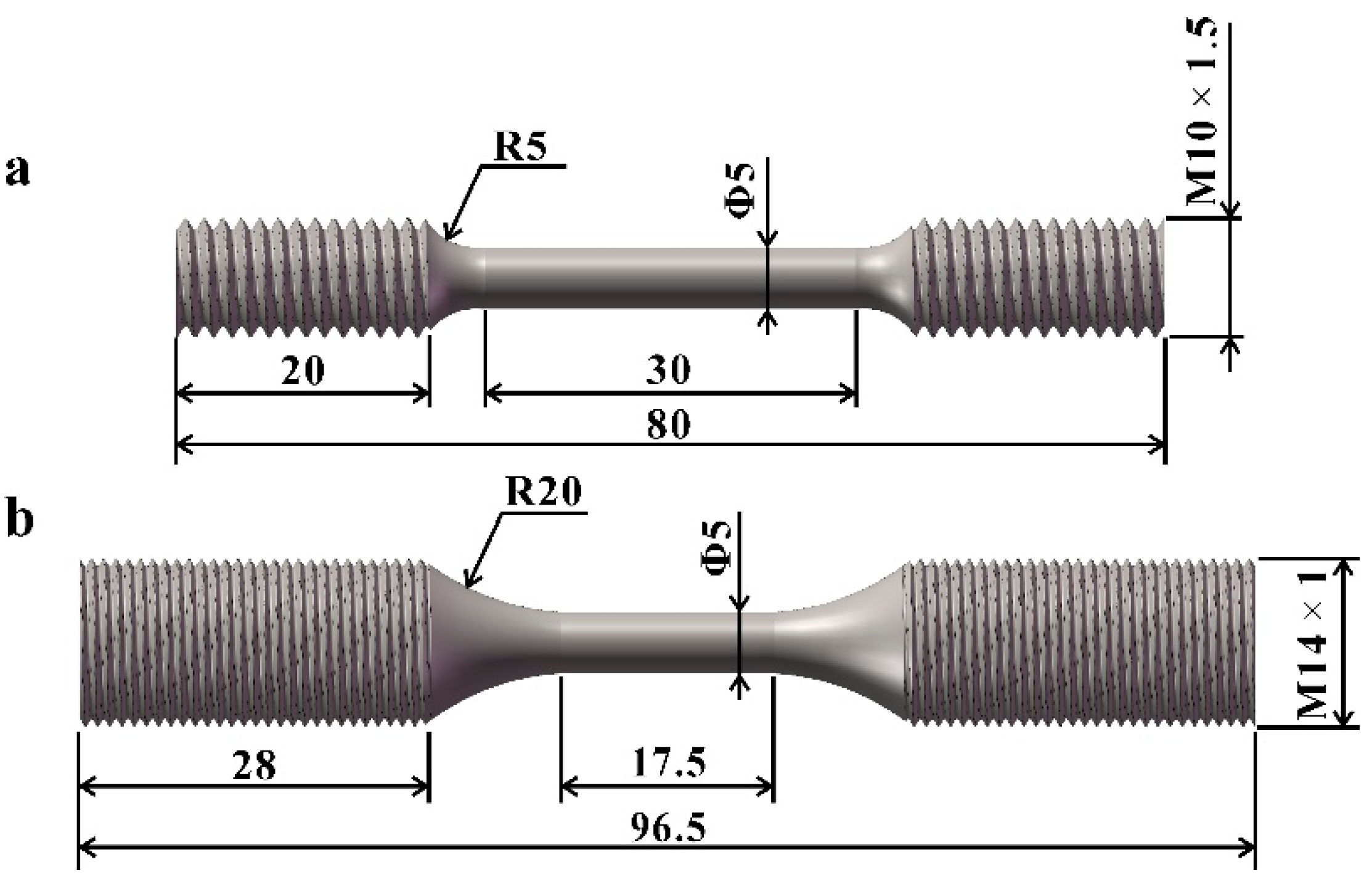
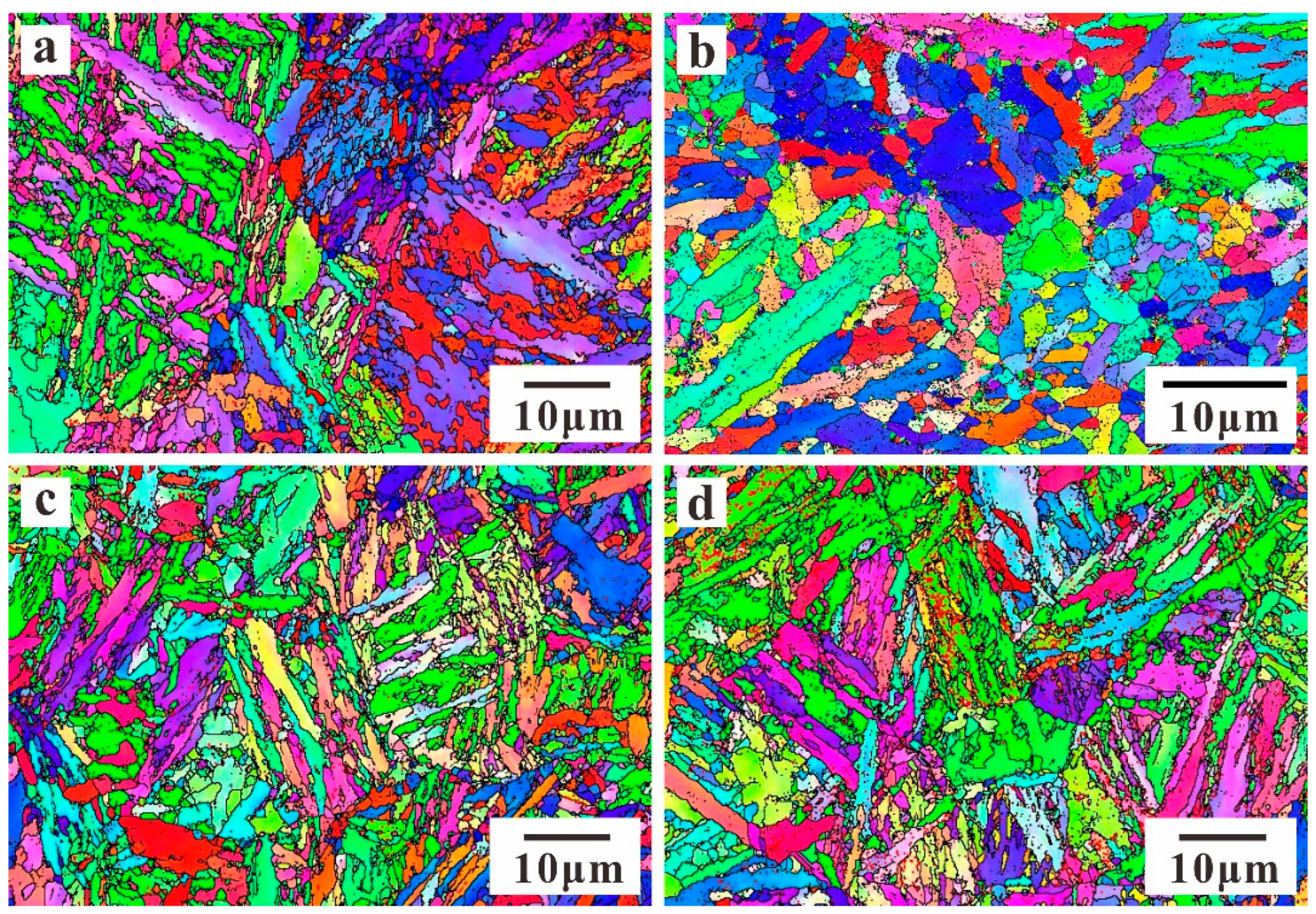
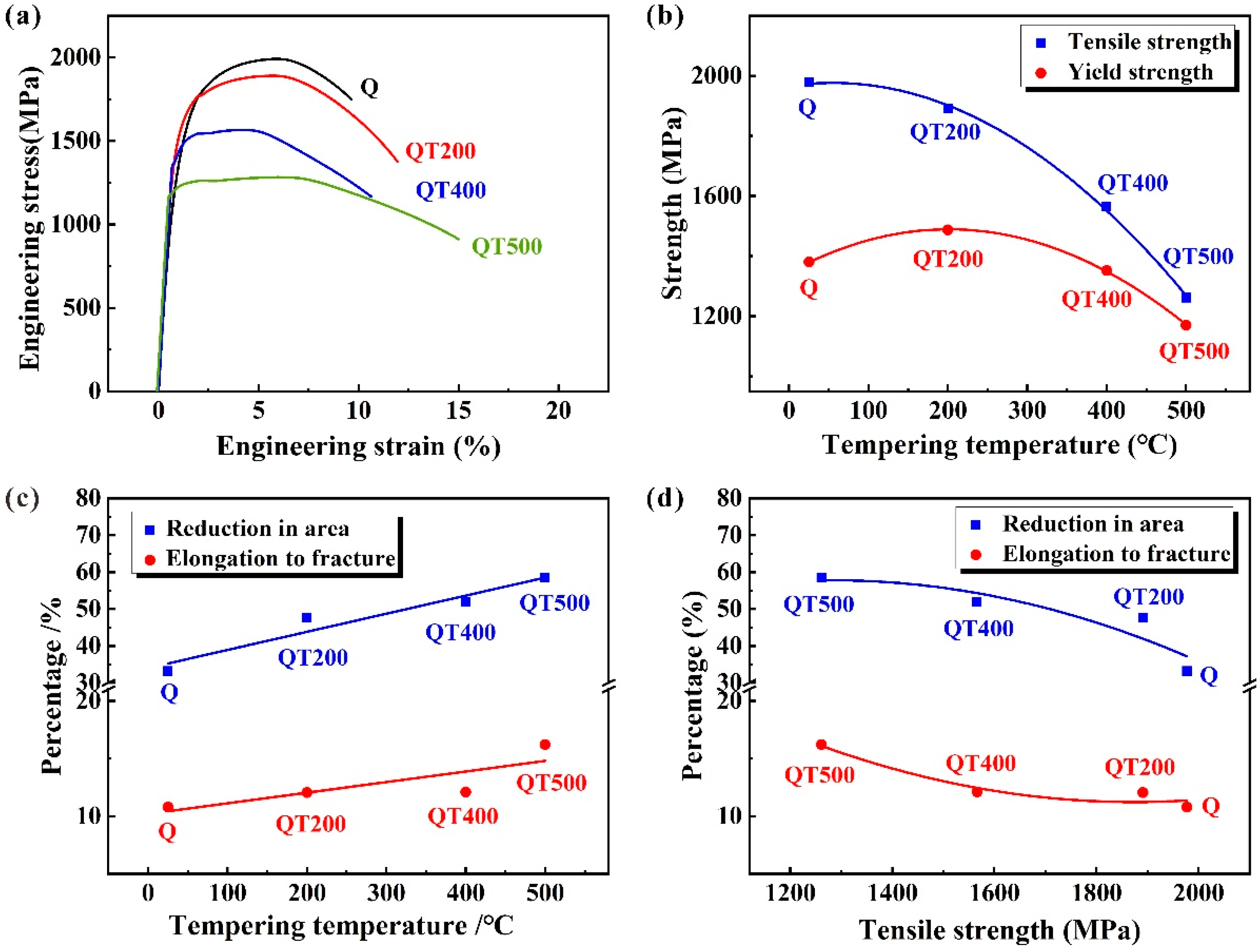
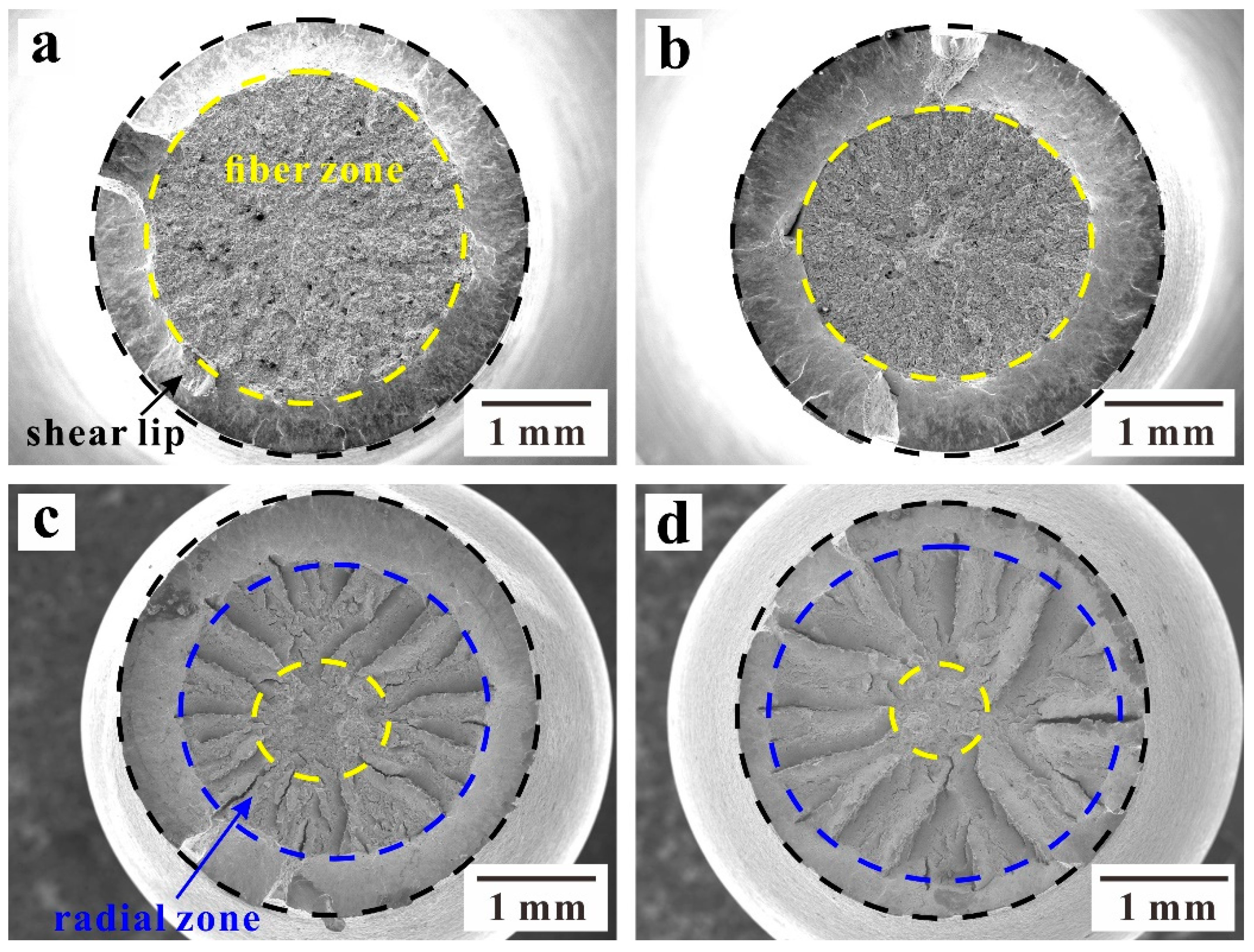

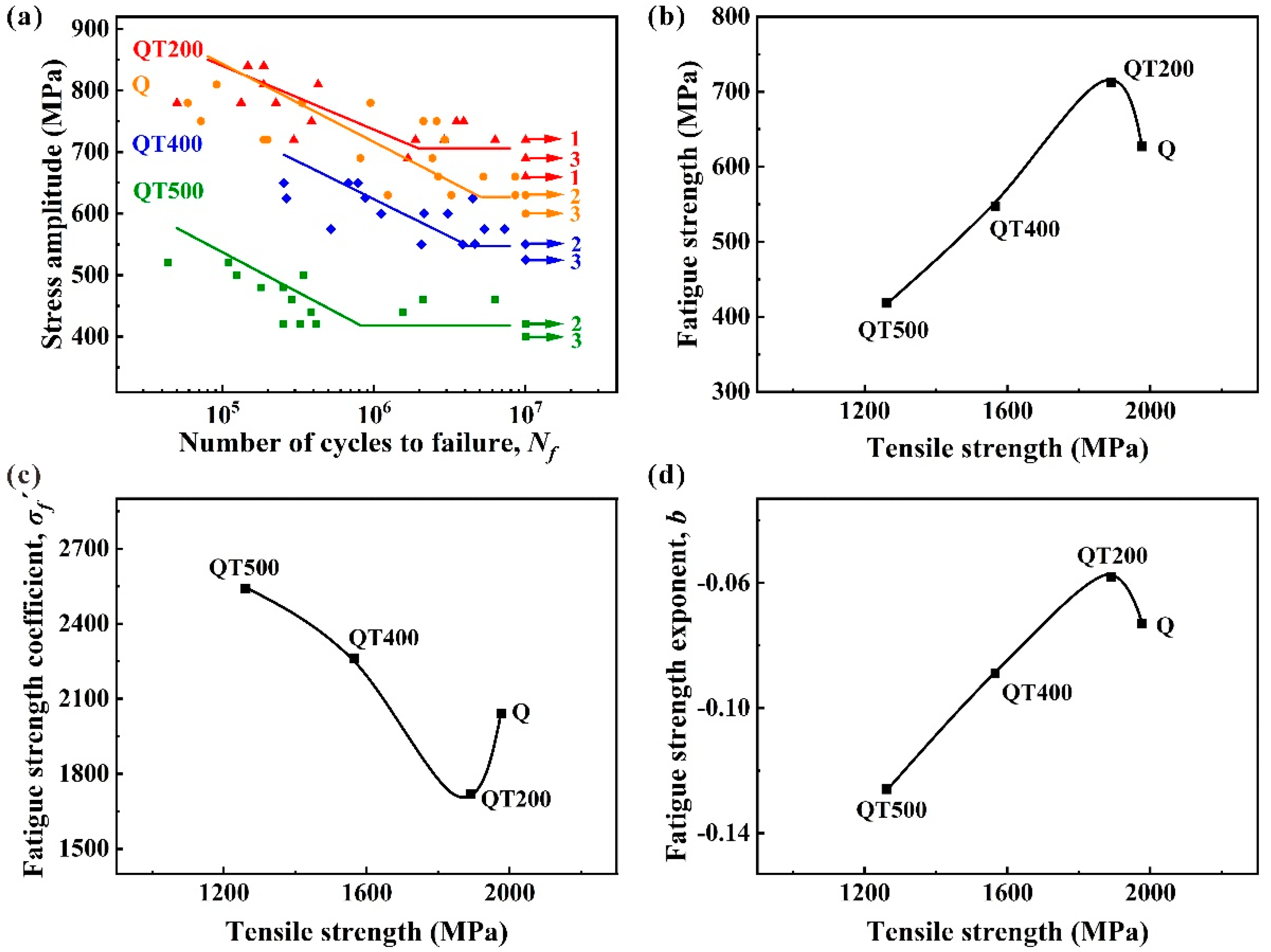

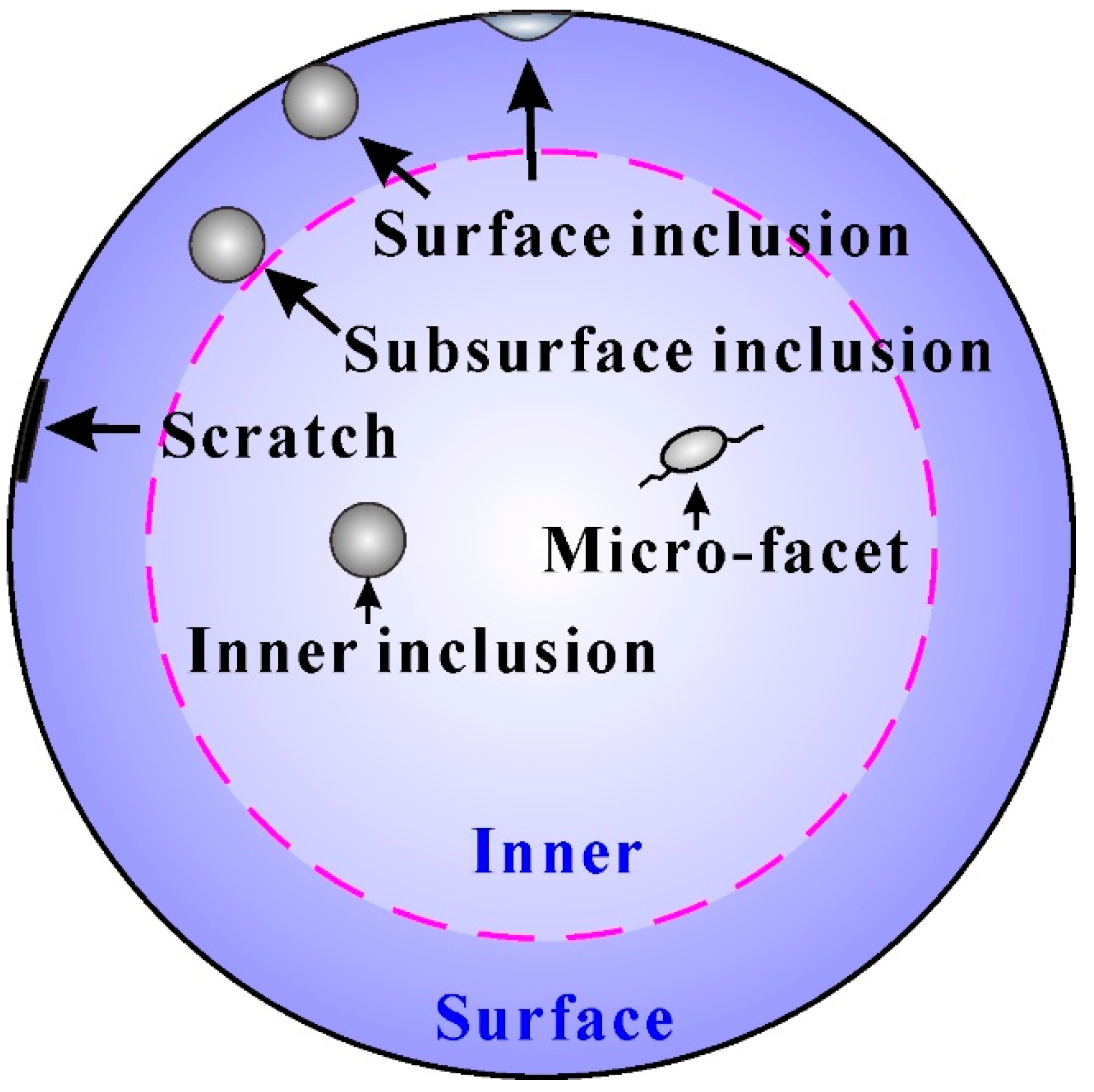


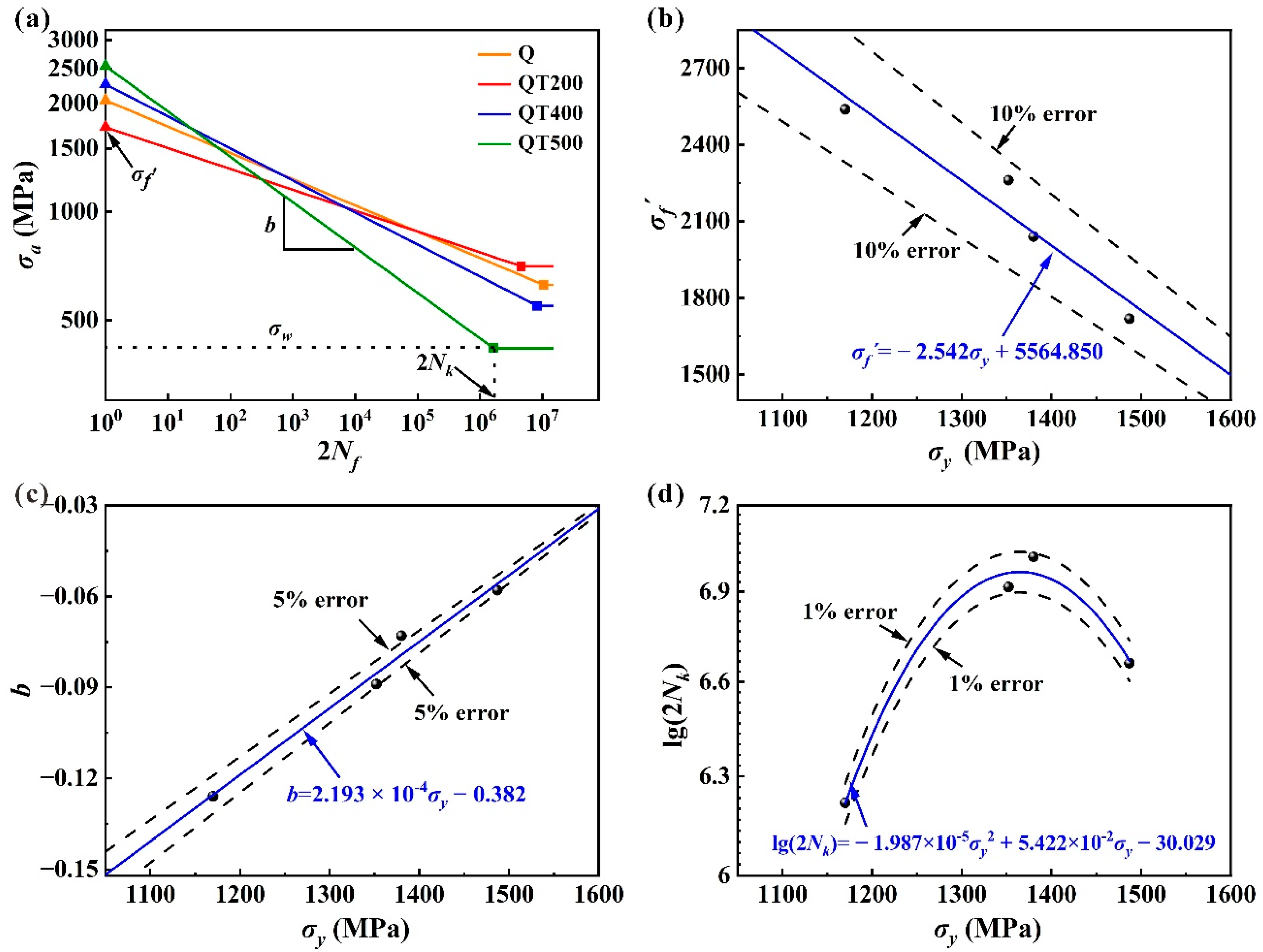

| C | Si | Mn | Cr | Mo | P | S | Fe |
|---|---|---|---|---|---|---|---|
| 0.35 | 0.35 | 0.76 | 1.13 | 0.20 | <0.005 | <0.001 | Balance |
| Samples | Quenching | Tempering |
|---|---|---|
| Q | Preheating to 860 °C for 30 min and quenching in oil | Untempered |
| QT200 | 200 °C tempering for 90 min | |
| QT400 | 400 °C tempering for 90 min | |
| QT500 | 500 °C tempering for 90 min |
| Sample | σb/MPa | σy/MPa | Z/% | A/% |
|---|---|---|---|---|
| Q | 1977 | 1380 | 33.20 | 10.80 |
| QT200 | 1891 | 1487 | 47.66 | 12.05 |
| QT400 | 1566 | 1352 | 51.84 | 12.10 |
| QT500 | 1261 | 1170 | 58.53 | 16.20 |
| Sample | σw/MPa | σf′ | b |
|---|---|---|---|
| Q | 627 | 2040.42 | −0.073 |
| QT200 | 706 | 1718.57 | −0.058 |
| QT400 | 548 | 2261.03 | −0.089 |
| QT500 | 418 | 2539.02 | −0.126 |
Publisher’s Note: MDPI stays neutral with regard to jurisdictional claims in published maps and institutional affiliations. |
© 2022 by the authors. Licensee MDPI, Basel, Switzerland. This article is an open access article distributed under the terms and conditions of the Creative Commons Attribution (CC BY) license (https://creativecommons.org/licenses/by/4.0/).
Share and Cite
Yang, M.; Gao, C.; Pang, J.; Li, S.; Hu, D.; Li, X.; Zhang, Z. High-Cycle Fatigue Behavior and Fatigue Strength Prediction of Differently Heat-Treated 35CrMo Steels. Metals 2022, 12, 688. https://doi.org/10.3390/met12040688
Yang M, Gao C, Pang J, Li S, Hu D, Li X, Zhang Z. High-Cycle Fatigue Behavior and Fatigue Strength Prediction of Differently Heat-Treated 35CrMo Steels. Metals. 2022; 12(4):688. https://doi.org/10.3390/met12040688
Chicago/Turabian StyleYang, Mengqi, Chong Gao, Jianchao Pang, Shouxin Li, Dejiang Hu, Xiaowu Li, and Zhefeng Zhang. 2022. "High-Cycle Fatigue Behavior and Fatigue Strength Prediction of Differently Heat-Treated 35CrMo Steels" Metals 12, no. 4: 688. https://doi.org/10.3390/met12040688
APA StyleYang, M., Gao, C., Pang, J., Li, S., Hu, D., Li, X., & Zhang, Z. (2022). High-Cycle Fatigue Behavior and Fatigue Strength Prediction of Differently Heat-Treated 35CrMo Steels. Metals, 12(4), 688. https://doi.org/10.3390/met12040688







